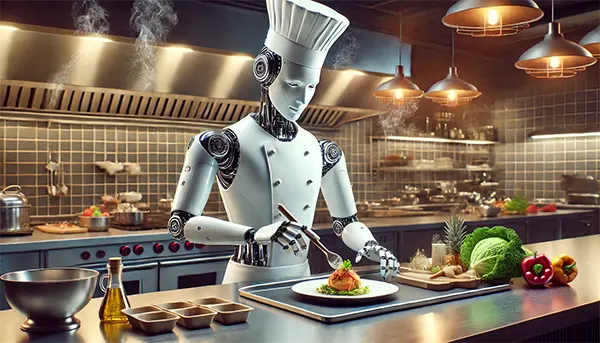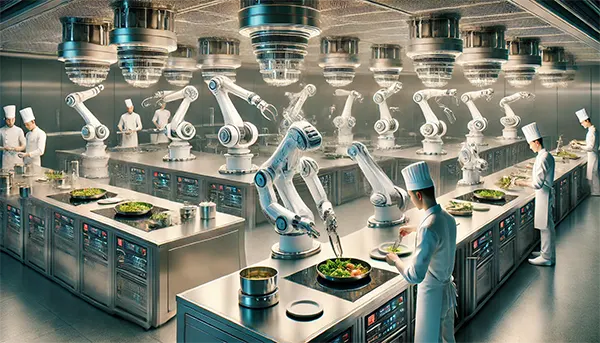Robotic Chefs: Is the World Ready for AI Integration in the Food Industry?

The integration of artificial intelligence (AI) into the food industry has evolved rapidly, with robotic chefs now becoming a reality rather than a futuristic concept. While automation in food preparation offers numerous benefits, it also raises questions about feasibility, efficiency, and societal acceptance. Are we truly ready for a world where robots take over the culinary space?
The Evolution of Robotic Chefs in the Culinary Industry
AI-driven kitchen robots have been in development for years, with prototypes capable of handling complex cooking tasks. From flipping burgers in fast-food chains to preparing intricate gourmet dishes, robotic chefs are revolutionising food production. Companies like Moley Robotics and Creator have already introduced functional AI-powered cooking systems.
The appeal of robotic chefs lies in their precision, efficiency, and ability to work without fatigue. Unlike human cooks, robots do not require breaks, salaries, or healthcare benefits, making them cost-effective for businesses in the long run. Their integration also ensures standardised food quality, minimising human error.
Despite these advancements, AI-driven cooking systems face significant hurdles. High initial costs, the need for constant maintenance, and public scepticism about fully automated food preparation create barriers to widespread adoption. Additionally, fine-tuned taste and creativity in cooking remain challenging for robots to replicate.
How AI is Transforming Restaurant Operations
Restaurants have already begun implementing AI-driven automation in various aspects of their operations. From self-ordering kiosks and smart inventory management to robotic food assembly, AI is streamlining efficiency and reducing operational costs.
One of the most significant transformations is in food preparation. Chains such as White Castle and McDonald’s have tested AI fry cooks and automated burger stations. These systems ensure speed and consistency, allowing for increased order capacity while maintaining food quality.
However, challenges remain. Customer perception is a major factor, as many diners still prefer human interaction and the authenticity of handcrafted meals. Additionally, not all cuisines can be replicated by AI, particularly those requiring complex flavour balancing and culinary artistry.
Societal Impact and Workforce Implications
The rise of robotic chefs raises concerns about employment displacement. The food industry is a significant source of jobs worldwide, with millions of workers relying on it for their livelihoods. The increasing use of AI in restaurants and industrial kitchens could lead to reduced demand for human cooks.
On the other hand, AI implementation creates new opportunities in the fields of robotics maintenance, AI programming, and food tech development. The industry shift may lead to a transformation in job roles rather than a complete replacement of human workers.
Additionally, ethical considerations arise regarding accessibility and affordability. AI-driven food preparation might be financially viable for large corporations, but smaller businesses may struggle to integrate such technology. The divide between AI-enhanced restaurants and traditional kitchens could widen, impacting market competition.
Consumer Acceptance of AI in Food Services
Consumer perception plays a crucial role in the adoption of AI-powered kitchen robots. While some embrace the convenience and consistency of automated cooking, others express concerns about hygiene, safety, and the lack of personal touch.
Surveys indicate that younger generations are more open to AI-driven food services, particularly in fast-food and casual dining environments. However, fine dining and artisanal culinary experiences still rely on the expertise and creativity of human chefs, making AI adoption less appealing in these sectors.
Trust in AI food safety standards will also be a key factor. Regulatory bodies must establish strict guidelines to ensure that AI-operated kitchens maintain the highest hygiene and food handling standards to gain public confidence.

The Future of AI in the Culinary World
As technology continues to advance, AI-driven chefs are likely to become more sophisticated, capable of adapting to personalised taste preferences and even creating original recipes. The integration of machine learning could allow robots to refine their techniques based on customer feedback.
AI is also expected to play a role in sustainable food practices. Automated systems can optimise ingredient use, minimise food waste, and improve energy efficiency, making them valuable tools in combating environmental challenges in the food industry.
However, complete AI dominance in the culinary world remains unlikely. The human touch, cultural significance of cooking, and the emotional connection people have with food make it difficult for AI to fully replace traditional chefs.
Balancing AI Integration and Culinary Tradition
The key to successful AI integration in the food industry lies in balance. Rather than replacing human chefs, AI can act as an assistant, enhancing efficiency while allowing culinary professionals to focus on creativity and innovation.
Hybrid kitchens, where AI handles repetitive tasks while humans oversee quality and artistic elements, may become the future of food service. This model ensures a seamless combination of technological advancement and traditional craftsmanship.
Ultimately, while the world is moving towards AI-driven food preparation, full adoption will depend on consumer trust, affordability, and the ability of robots to complement rather than replace human expertise.
